Caryn’s Thoughts
Oh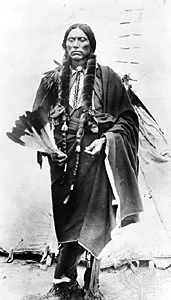 The great Comanche chief and war leader, Quanah Parker became a leader at a young age, and he was known for his bravery and his aggression as a warrior. I was drawn to this chief mostly because of his unusual name…both first and last. The first name was one I had never heard before, and the last seemed unusual for an Indian. Parker was born around 1848, near Wichita Falls, Texas, and died February 23, 1911, at Cache, near Fort Sill, Oklahoma. Quanah was the son of Chief Peta Nocona and Cynthia Ann Parker, a white woman captured by the Comanches as a child. Quanah is a Native American name that means “fragrant, or sweet smelling.” Quanah later added his mother’s surname to his given name. Their family was very happy until 1860, when the Texas Rangers attacked their encampment on the Pease River. While the stories of this event vary, there is no doubt that changed Quanah’s family forever, when the Rangers decided that Cynthia Ann and her young daughter, Prairie Flower should be returned to her people, even though that was against her wishes. It is believed that Quanah and Nocona were not there when the raid took place.
The great Comanche chief and war leader, Quanah Parker became a leader at a young age, and he was known for his bravery and his aggression as a warrior. I was drawn to this chief mostly because of his unusual name…both first and last. The first name was one I had never heard before, and the last seemed unusual for an Indian. Parker was born around 1848, near Wichita Falls, Texas, and died February 23, 1911, at Cache, near Fort Sill, Oklahoma. Quanah was the son of Chief Peta Nocona and Cynthia Ann Parker, a white woman captured by the Comanches as a child. Quanah is a Native American name that means “fragrant, or sweet smelling.” Quanah later added his mother’s surname to his given name. Their family was very happy until 1860, when the Texas Rangers attacked their encampment on the Pease River. While the stories of this event vary, there is no doubt that changed Quanah’s family forever, when the Rangers decided that Cynthia Ann and her young daughter, Prairie Flower should be returned to her people, even though that was against her wishes. It is believed that Quanah and Nocona were not there when the raid took place.
Quanah Parker was the last chief of the Kwahadi (Quahadi) band. He mounted an unsuccessful war against white expansion in northwestern Texas between 1874 and 1875. When that failed, he became the main spokesman and peacetime leader of the Native Americans in the region, a role which he performed for 30 years.
Quanah was a tall and muscular man, who became a full warrior at age 15. His reputation as an aggressive and fearless fighter was established after a series of successful raids. He became a war chief at a relatively young age as well, having gained the respect of his people. Quanah moved between several Comanche bands before joining the fierce Kwahadi, who were particularly bitter enemies of the hunter. The white Buffalo hunters had appropriated the best land on the Texas frontier and were decimating the buffalo herds. In order to stem the onslaught of Comanche attacks on settlers and travelers, the US government relegated the Indians to reservations in 1867. Quanah and his band refused to cooperate and continued their raids. Attempts by the US military to locate them were unsuccessful. In June 1874 Quanah and Isa-Tai, a medicine man who claimed to have a potion that would protect the Indians from bullets, gathered 250–700 warriors from among the Comanche, Cheyenne, and Kiowa and attacked about 30 white buffalo hunters quartered at Adobe Walls, Texas. The raid was a failure for the Kwahadi because a saloon owner had allegedly been warned of the attack, and the US military retaliated in force in what became known as the Red River Indian War. Quanah’s group held out on the Staked Plains for almost a year before he finally surrendered at Fort Sill.
Eventually Quanah agreed to settle on a reservation in southwestern Oklahoma, and he persuaded other Comanche bands to conform too. He soon became known as the principal chief of all Comanche. It was a position that had never existed before, and so was a great honor. As the chief of all Comanche, over the next three decades, he was the main interpreter of white civilization to his people, encouraging education and agriculture. He also tried to be an advocate on behalf of the Comanche, and soon became a successful businessman as well. Quanah also maintained elements of his own Indian culture, including polygamy, and he played a major role in creating a Peyote Religion that spread from 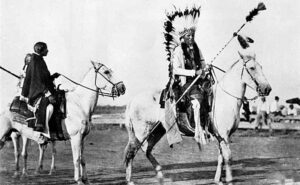 the Comanche to other tribes. He soon became a national figure, developing friendships with numerous notable men, including President Theodore Roosevelt, who invited Quanah to his inauguration in 1905. Roosevelt also visited Quanah at the chief’s home, a 10-room residence known as Star House, in Cache, Oklahoma.
the Comanche to other tribes. He soon became a national figure, developing friendships with numerous notable men, including President Theodore Roosevelt, who invited Quanah to his inauguration in 1905. Roosevelt also visited Quanah at the chief’s home, a 10-room residence known as Star House, in Cache, Oklahoma.
Quanah passed away in 1911, and was buried next to his mother, whose assimilation back into white civilization had been very difficult. Her white family blocked her repeated attempts to rejoin the Comanche, and in 1864 Prairie Flower died. Cynthia Ann was miserable and reportedly starved herself to death in 1870.
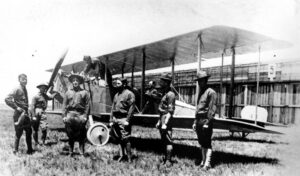 Imagine a time when there was no air force, or for that matter, airplanes. Of course, for those of us living today, that would be very hard to imagine…in fact, maybe impossible. Nevertheless, before the Wright brothers made flight possible, there was not only no planes, but no air force. Then, in 1914, things were about to change forever.
Imagine a time when there was no air force, or for that matter, airplanes. Of course, for those of us living today, that would be very hard to imagine…in fact, maybe impossible. Nevertheless, before the Wright brothers made flight possible, there was not only no planes, but no air force. Then, in 1914, things were about to change forever.
The First Aero Squadron was formed in 1914. It was organized after the start of World War I, but it was first used because of the Mexican revolutionary, Pancho Villa, who was initially a bandit, but later became a general in the Mexican Revolution. He was a key figure in the revolutionary violence that forced out President Porfirio Díaz and brought Francisco Madero to power in 1911. Pancho Villa was an excellent guerrilla leader who fought against the regimes of both of those men. After 1914, he engaged in civil war and banditry. He became notorious in the United States for his attack on Columbus, New Mexico, in 1916, and something had to be done
On March 9, 1916, Villa, who opposed American support for Mexican President Venustiano Carranza, led a band of several hundred guerrillas across the border on a raid of the town of Columbus, New Mexico. Seventeen Americans were killed in the battle. On March 15, President Woodrow Wilson ordered, US Brigadier General John J Pershing to launch a punitive expedition into Mexico to capture Villa. Four days later, the First Aero Squadron was sent into Mexico to scout and relay messages for General Pershing. On March 19, 1914, Eight Curtiss “Jenny” planes of the First Aero Squadron took off from Columbus, New Mexico, in the first combat air mission in United States history. The squadron was on a support mission for the 7,000 US troops who invaded Mexico to capture Villa.

Despite encountering numerous mechanical and navigational problems, the American pilots flew hundreds of missions for Pershing during which they gained important experience that would later be used by fliers over the battlefields of Europe. Unfortunately, during the 11-month mission, US forces failed to capture the elusive revolutionary, and Mexican resentment over US intrusion into their territory led to a diplomatic crisis. In late January 1917, with President Wilson under pressure from the Mexican government and more concerned with the war overseas than with bringing Villa to justice, the Americans were ordered home. The missions were over.
 Why would the United States secretly bomb a neutral nation in the middle of a war with an enemy nation? That is the question I have been asking myself concerning the Menu Bombings…the bombing of neutral Cambodia during the Vietnam war. It was thought that bombing supply routes in Cambodia would weaken the enemies of the United States. I’m not sure that worked exactly. It did cut off the supply line, but innocent people were caught in the crossfire. Nevertheless, the decision was made to bomb Cambodia, and also to keep it a secret from the American public, who would most likely feel about it the same way, I do. Intentionally bombing innocent people just rubs most of us the wrong way.
Why would the United States secretly bomb a neutral nation in the middle of a war with an enemy nation? That is the question I have been asking myself concerning the Menu Bombings…the bombing of neutral Cambodia during the Vietnam war. It was thought that bombing supply routes in Cambodia would weaken the enemies of the United States. I’m not sure that worked exactly. It did cut off the supply line, but innocent people were caught in the crossfire. Nevertheless, the decision was made to bomb Cambodia, and also to keep it a secret from the American public, who would most likely feel about it the same way, I do. Intentionally bombing innocent people just rubs most of us the wrong way.
On March 15, 1969, President Richard Nixon approved the plan to bomb Cambodia. The actual missions began 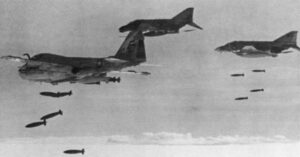 on March 18, 1969, when US B-52 bombers are diverted from their targets in South Vietnam to attack suspected communist base camps and supply areas in Cambodia for the first time in the war. This mission, originally intended to be called Operation Breakfast, and subsequent B-52 strikes inside Cambodia became known as the “Menu” bombings. The strikes included a total of 3,630 flights over Cambodia dropping 110,000 tons of bombs during a 14-month period through April 1970. This bombing of Cambodia and all follow up “Menu” operations were kept secret from the American public and the US Congress because Cambodia was considered a neutral nation. The missions had to be kept secret to avoid a public outcry…so, an intricate reporting system was established at the Pentagon to prevent disclosure of the bombing.
on March 18, 1969, when US B-52 bombers are diverted from their targets in South Vietnam to attack suspected communist base camps and supply areas in Cambodia for the first time in the war. This mission, originally intended to be called Operation Breakfast, and subsequent B-52 strikes inside Cambodia became known as the “Menu” bombings. The strikes included a total of 3,630 flights over Cambodia dropping 110,000 tons of bombs during a 14-month period through April 1970. This bombing of Cambodia and all follow up “Menu” operations were kept secret from the American public and the US Congress because Cambodia was considered a neutral nation. The missions had to be kept secret to avoid a public outcry…so, an intricate reporting system was established at the Pentagon to prevent disclosure of the bombing.

Somehow, the story was leaked by the New York Times in May of 1969, but there was little adverse public reaction. Now I find that incredible. The people were so “asleep” that they hardly noticed the bombing of a neutral country. It makes me wonder just how long the people have been asleep. How could people simply take no notice of such a huge violation of the rules of war. I’m sure there are things I don’t know about this war…lots of things, in fact, but I don’t think it is proper for our government to hide things for the people…especially such a big set of bombing missions on a neutral country. The people of this nation need to open our eyes and watch what our government is doing…before it’s too late.

 Once a year, we find ourselves puttin’ on a little bit o’ the Irish style, to step out and partake of the green Guinness beer, Corned Beef and Cabbage, and a number of other Irish treats, as we celebrate Saint Patrick’s Day. The day really isn’t about wearing green clothes, so you don’t get pinched, or drinking green beer, but rather a day to celebrate Saint Patrick, who came to Ireland in the fifth century and brought many of the people to Christ. In fact, in Ireland, the day is not a party day, but rather, a religious holiday, similar to Christmas and Easter. Things have changed some over the years, and these days you can find Saint Patrick’s Day parades, shamrocks, and green Guinness beer in Ireland, but it’s mostly there for the tourists who think that is the right way to celebrate the day. For most of the Irish people, however it would not be that way, and in fact, up until 1970 Irish laws mandated that pubs be closed on Saint Patrick’s Day. That is a stark contrast to the way the day is celebrated here, but the holiday doesn’t mean the same thing to Americans. I suppose that our Independence Day doesn’t mean the same thing to the Irish either.
Once a year, we find ourselves puttin’ on a little bit o’ the Irish style, to step out and partake of the green Guinness beer, Corned Beef and Cabbage, and a number of other Irish treats, as we celebrate Saint Patrick’s Day. The day really isn’t about wearing green clothes, so you don’t get pinched, or drinking green beer, but rather a day to celebrate Saint Patrick, who came to Ireland in the fifth century and brought many of the people to Christ. In fact, in Ireland, the day is not a party day, but rather, a religious holiday, similar to Christmas and Easter. Things have changed some over the years, and these days you can find Saint Patrick’s Day parades, shamrocks, and green Guinness beer in Ireland, but it’s mostly there for the tourists who think that is the right way to celebrate the day. For most of the Irish people, however it would not be that way, and in fact, up until 1970 Irish laws mandated that pubs be closed on Saint Patrick’s Day. That is a stark contrast to the way the day is celebrated here, but the holiday doesn’t mean the same thing to Americans. I suppose that our Independence Day doesn’t mean the same thing to the Irish either.
In the United States, Saint Patrick’s Day is a day to celebrate out Irish roots, and to participate in a little playful silliness. We celebrate with “pub crawls” and green coloring in rivers. While the Chicago River is the most prominent green river on Saint Patrick’s Day, there are currently others working to emulate the same effects or have done so in the past. The Irish Marching Society decided to bring the tradition to Rockford, Illinois and dye Rock River last year. San Antonio, Texas; Savannah, Georgia; Indianapolis, Indiana; Charlotte, North Carolina; Tampa, Florida; and Washington DC have all dyed various rivers green. In 2020, city officials in Dublin, Ireland decided to get in on the fun by dying the River Liffey green…as a way to get everyone involved.
I think most of us have some Irish background, but people may not know it. It seems to me that a lot of people have immigrated from Ireland over the years. In fact, many industries like mining and the rail roads, likely 
 would have been a ways behind where they were with the Irish immigrants. With the number of Irish immigrants that came over, there are probably very few families who don’t have a least a little bit of the Irish in them. Nevertheless, Irish or not, most of us like to celebrate the wearin’ of the green every year when Saint Paddy’s Day rolls around. So, whether you drink green beer or eat corned beef and cabbage, or simply wear green so you don’t get pinched, happy Saint Patrick’s Day to you all!!
would have been a ways behind where they were with the Irish immigrants. With the number of Irish immigrants that came over, there are probably very few families who don’t have a least a little bit of the Irish in them. Nevertheless, Irish or not, most of us like to celebrate the wearin’ of the green every year when Saint Paddy’s Day rolls around. So, whether you drink green beer or eat corned beef and cabbage, or simply wear green so you don’t get pinched, happy Saint Patrick’s Day to you all!!
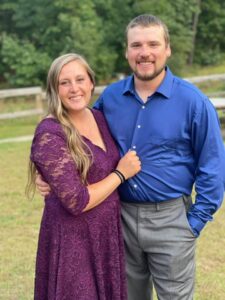
 When you live on a farm, with multiple animals, the work never ends. My nephew, Eric Parmely married a girl named Ashley, who was raised on a farm, and they are on a life journey that is probably pretty unusual in this day and age. They bought a farm west of Casper, Wyoming, and they both work very hard raising horses, cows, goats, pigs, turkeys, and chickens, not to mention dogs and cats. The baby count grows every year, and of course, the animals supply the family with meat, eggs, milk, and of course, love…especially from the dogs and cats, but from the other animals too.
When you live on a farm, with multiple animals, the work never ends. My nephew, Eric Parmely married a girl named Ashley, who was raised on a farm, and they are on a life journey that is probably pretty unusual in this day and age. They bought a farm west of Casper, Wyoming, and they both work very hard raising horses, cows, goats, pigs, turkeys, and chickens, not to mention dogs and cats. The baby count grows every year, and of course, the animals supply the family with meat, eggs, milk, and of course, love…especially from the dogs and cats, but from the other animals too.
Eric’s workday doesn’t really end until his head the pillow. Eric is always working on something. Eric and Ashley host a family dinner for our families once a month, and after dinner, the work must usually go on. Sunday when we were out there, he and several of the men were out working on his 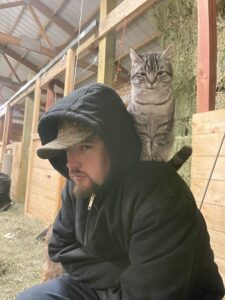
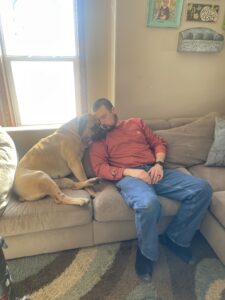 tractor. You can’t run a farm without a tractor, and there is always something that needs done on it…either repairs or maintenance. Then he and Ashley have jobs like milking the cow and the goats, feeding all the animals, and stacking hay (when they buy bales).
tractor. You can’t run a farm without a tractor, and there is always something that needs done on it…either repairs or maintenance. Then he and Ashley have jobs like milking the cow and the goats, feeding all the animals, and stacking hay (when they buy bales).
Eric is a great daddy. He gives the best “daddy horse” rides and tickles…which we all know is very important…especially the tickles to his kids, Reagan, Hattie, Bowen, and Maeve!! He is always helping Ashley with the household chores and is an expert at washing dishes and folding laundry. You might say he has dozens and dozens of babies, because he also loves to snuggle the kittens and puppies, and he helps pull calves. Eric really has a heart of gold and is filled with love for his kids, wife, and animals.
In the little bit of down time he has, Eric likes to watch videos on YouTube on his phone and giggles to himself. 
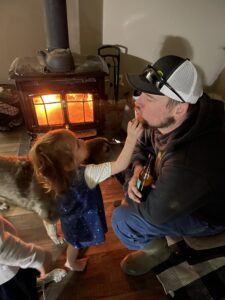 He rather reminds me of his Uncle Bob in that way. It doesn’t matter if it’s on television or his phone, Bob gets a kick out of comedy, just like Eric. It’s fun to listen to their laughter from the other room, and ultimately, you can’t help but laugh along, even if you don’t know what is so funny. Just hearing their laughter is contagious, and you find yourself laughing along…or at the very least smiling. Ashley tells me that Eric is still a mama’s boy, and that is likely true. I think Eric would help his mom, Jennifer Parmely and her partner, Brian Cratty with anything they needed, and I think he would help his in-laws, Kari and Albert Eighmy with anything they needed too. That’s just the kind of guy Eric is. Today is Eric’s birthday. Happy birthday Eric!! Have a great day!! We love you!!
He rather reminds me of his Uncle Bob in that way. It doesn’t matter if it’s on television or his phone, Bob gets a kick out of comedy, just like Eric. It’s fun to listen to their laughter from the other room, and ultimately, you can’t help but laugh along, even if you don’t know what is so funny. Just hearing their laughter is contagious, and you find yourself laughing along…or at the very least smiling. Ashley tells me that Eric is still a mama’s boy, and that is likely true. I think Eric would help his mom, Jennifer Parmely and her partner, Brian Cratty with anything they needed, and I think he would help his in-laws, Kari and Albert Eighmy with anything they needed too. That’s just the kind of guy Eric is. Today is Eric’s birthday. Happy birthday Eric!! Have a great day!! We love you!!

 My niece, Kellie Hadlock has been in a period of growth. So much is changing in her life. A while back, Kellie bought her own house, and now, she has time and space to grow…and grow she is. Kellie has been concentrating on her relationship with the Lord. She is now fully engaged in daily Bible study, and you can actually see that she is growing in knowledge and in truth, and that the Word she is reading is planted deeply in her heart. Kellie has been one of the worship leaders in our church, Word Christian Fellowship Church, for a number of years now, and the love she has for the Lord shows in every song she sings. Kellie has always been a “smiley girl,” and that has served her well in her role as worship leader. I know that as one of the backup singers, I always tell myself to watch Kellie, so I remember to smile too, because I tend to be more serious. She has helped me more than she will ever know. It is wonderful, for all who know Kellie, to see her actively growing in her relationship with the Lord, and as worship leader. She is becoming a great woman of God!!
My niece, Kellie Hadlock has been in a period of growth. So much is changing in her life. A while back, Kellie bought her own house, and now, she has time and space to grow…and grow she is. Kellie has been concentrating on her relationship with the Lord. She is now fully engaged in daily Bible study, and you can actually see that she is growing in knowledge and in truth, and that the Word she is reading is planted deeply in her heart. Kellie has been one of the worship leaders in our church, Word Christian Fellowship Church, for a number of years now, and the love she has for the Lord shows in every song she sings. Kellie has always been a “smiley girl,” and that has served her well in her role as worship leader. I know that as one of the backup singers, I always tell myself to watch Kellie, so I remember to smile too, because I tend to be more serious. She has helped me more than she will ever know. It is wonderful, for all who know Kellie, to see her actively growing in her relationship with the Lord, and as worship leader. She is becoming a great woman of God!!
As an aunt, she is among the most beloved aunts I know. Her nephew, Ethan Hadlock, and nieces, Aurora 
 Hadlock, Adelaide Sawdon, and Mackenzie Moore, flock to her whenever she is near. She loves children and is a great “step-mom” to her boyfriend, Tim Thompson’s daughter, Jolene. She is also a great “doggie mom” to her little puppy, Leena and to Tim’s dog, Jett. Unfortunately, Kellie and Tim don’t live in the same city right now, so they have been spending time going back and forth visiting each other in their long distance (but not too far, only from Casper, Wyoming to Gillette, Wyoming) relationship. Lovebirds will always find a way, and these two have made it work.
Hadlock, Adelaide Sawdon, and Mackenzie Moore, flock to her whenever she is near. She loves children and is a great “step-mom” to her boyfriend, Tim Thompson’s daughter, Jolene. She is also a great “doggie mom” to her little puppy, Leena and to Tim’s dog, Jett. Unfortunately, Kellie and Tim don’t live in the same city right now, so they have been spending time going back and forth visiting each other in their long distance (but not too far, only from Casper, Wyoming to Gillette, Wyoming) relationship. Lovebirds will always find a way, and these two have made it work.
And speaking of Tim…he has really brought Kellie out of her wheelhouse and into activities that none of us would have ever expected Kellie to be involved in. Tim is an outdoorsman, and he has taken Kellie along with 
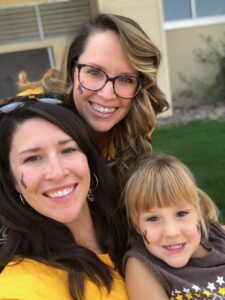 him on his trips. She, of course, was open to going and has found that she really loves doing things like hunting, ice fishing, axe throwing, and archery. As her sister Lindsay Moore said, and I agree…Who saw that coming?!? Kellie really never seemed the “woman of the great outdoors” type, with the exception of going camping. Of course, when I say camping, I mean in a travel trailer and mostly sitting around the campfire. Now, all that has changed. She’s like “Annie Oakley” or something, and for her it’s a whole new wheelhouse. Kellie has always had a positive outlook on life, and she is open-minded, so it shouldn’t have been so surprising. Nevertheless, somehow it was. She’s a whole new Kellie. Today is Kellie’s birthday. Happy birthday Kellie!! Have a great day!! We love you!!
him on his trips. She, of course, was open to going and has found that she really loves doing things like hunting, ice fishing, axe throwing, and archery. As her sister Lindsay Moore said, and I agree…Who saw that coming?!? Kellie really never seemed the “woman of the great outdoors” type, with the exception of going camping. Of course, when I say camping, I mean in a travel trailer and mostly sitting around the campfire. Now, all that has changed. She’s like “Annie Oakley” or something, and for her it’s a whole new wheelhouse. Kellie has always had a positive outlook on life, and she is open-minded, so it shouldn’t have been so surprising. Nevertheless, somehow it was. She’s a whole new Kellie. Today is Kellie’s birthday. Happy birthday Kellie!! Have a great day!! We love you!!

 The town of Spencer, Nebraska is a small town of just 423 people, but on March 14, 2019, the town became more well known that it probably ever dreamed it could, or even wanted to be. Suddenly, Spencer, Nebraska was big news, or at least the dam there was. Events unfolded that lead to the collapse of the 93-year-old dam, when the pressure from an icy flood mixed with an area that had a history of unaddressed ice problems. Perhaps it was the rural area of the state, or that they misjudged the surge that could follow a collapse, but they didn’t think that many people would be affected and certainly that no one would die, should the Spencer dam fail. That proved to be untrue, when Kenny Angel, who lived just beneath the dam, was found dead after the flood washed away his home and business. Workers for the Nebraska Public Power District, which operated the dam, warned Angel just minutes ahead of time of the impending danger.
The town of Spencer, Nebraska is a small town of just 423 people, but on March 14, 2019, the town became more well known that it probably ever dreamed it could, or even wanted to be. Suddenly, Spencer, Nebraska was big news, or at least the dam there was. Events unfolded that lead to the collapse of the 93-year-old dam, when the pressure from an icy flood mixed with an area that had a history of unaddressed ice problems. Perhaps it was the rural area of the state, or that they misjudged the surge that could follow a collapse, but they didn’t think that many people would be affected and certainly that no one would die, should the Spencer dam fail. That proved to be untrue, when Kenny Angel, who lived just beneath the dam, was found dead after the flood washed away his home and business. Workers for the Nebraska Public Power District, which operated the dam, warned Angel just minutes ahead of time of the impending danger.
The dam was operated by the Nebraska Public Power District (NPPD). Heavy precipitation during the March 2019 North American blizzard led to a failure of the dam in the early morning hours of March 14th, causing heavy flooding downstream. For a dam that was not expected to do much damage, if it failed, the damage was really devastating…affecting four counties. An 11-foot wall of water was released by the failure, as recorded by a US Geological Survey stream gage moments before it was washed away.
Nebraska regulators had categorized Spencer Dam as a “significant hazard,” which is a rating that meant no loss of life was expected if it failed. With that, no formal emergency action plan was required. After the collapse, it was noted that the Association of State Dam Safety Officials said the dam should have been rated as “high hazard,” which could have led to a plan to modify it to increase its flood capacity. Unfortunately, that was not done, and the failure was terrible. Knox County, the hardest hit of the four counties affected, saw estimates of more than $17M in damages. While the Spencer dam had a history of ice related issues, and other dams may have had ice issues too, the Spencer dam might just be the first dam in the nation to collapse due to 
 those ice issues. The 11-foot surge of water that followed the collapse took out roads, highways, homes, businesses, and bridges. For several months, motorists were required to detour 150 miles to get past the damage. The flood cut a new channel in the river, meaning a new 1050-foot section of the bridge on Highway 281 below the dam.
those ice issues. The 11-foot surge of water that followed the collapse took out roads, highways, homes, businesses, and bridges. For several months, motorists were required to detour 150 miles to get past the damage. The flood cut a new channel in the river, meaning a new 1050-foot section of the bridge on Highway 281 below the dam.
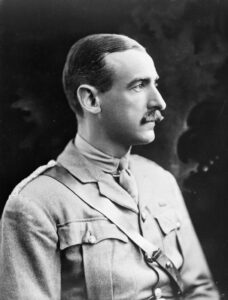 The unkillable soldier…a nickname that has deep ramifications, and a nickname no one really wants to have. It indicates that the soldier is wounded multiple times…and somehow survived. General Adrian Carton de Wiart was that soldier. He was born into an aristocratic family in Brussels, on May 5, 1880. He was the eldest son of Léon Constant Ghislain Carton de Wiart and Ernestine Wenzig. He spent his early days in Belgium and in England. When he was six years old, his parents divorced, and he moved with his father to Cairo. His mother remarried Demosthenes Gregory Cuppa later in 1886. His father was a lawyer and magistrate, as well as a director of the Cairo Electric Railways and Heliopolis Oases Company and was well connected in Egyptian governmental circles. Adrian Carton de Wiart learned to speak Arabic. He joined the British Army at the time of the Second Boer War around 1899, where he entered under the false name of “Trooper Carton,” claiming to be 25 years old, but he was actually 20. He was wounded in the stomach and groin in South Africa early in the Second Boer War and was sent home to recuperate. His father was furious when he learned his son had abandoned his studies. Nevertheless, he allowed his son to remain in the army.
The unkillable soldier…a nickname that has deep ramifications, and a nickname no one really wants to have. It indicates that the soldier is wounded multiple times…and somehow survived. General Adrian Carton de Wiart was that soldier. He was born into an aristocratic family in Brussels, on May 5, 1880. He was the eldest son of Léon Constant Ghislain Carton de Wiart and Ernestine Wenzig. He spent his early days in Belgium and in England. When he was six years old, his parents divorced, and he moved with his father to Cairo. His mother remarried Demosthenes Gregory Cuppa later in 1886. His father was a lawyer and magistrate, as well as a director of the Cairo Electric Railways and Heliopolis Oases Company and was well connected in Egyptian governmental circles. Adrian Carton de Wiart learned to speak Arabic. He joined the British Army at the time of the Second Boer War around 1899, where he entered under the false name of “Trooper Carton,” claiming to be 25 years old, but he was actually 20. He was wounded in the stomach and groin in South Africa early in the Second Boer War and was sent home to recuperate. His father was furious when he learned his son had abandoned his studies. Nevertheless, he allowed his son to remain in the army.
In 1908, he married Countess Friederike Maria Karoline Henriette Rosa Sabina Franziska Fugger von Babenhausen (1887 – 1949), eldest daughter of Karl, 5th Fürst (Prince) von Fugger-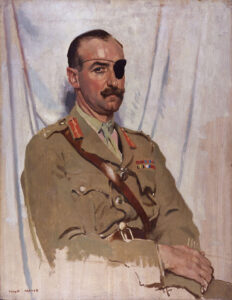 Babenhausen and Princess Eleonora zu Hohenlohe-Bartenstein und Jagstberg of Klagenfurt, Austria. They had two daughters, the elder of whom Anita (born 1909, now deceased) was the maternal grandmother of the war correspondent Anthony Loyd (born 1966). I wonder if Loyd was inspired by his grandfather’s story.
Babenhausen and Princess Eleonora zu Hohenlohe-Bartenstein und Jagstberg of Klagenfurt, Austria. They had two daughters, the elder of whom Anita (born 1909, now deceased) was the maternal grandmother of the war correspondent Anthony Loyd (born 1966). I wonder if Loyd was inspired by his grandfather’s story.
Over the course of his career, General Adrian Carton de Wiart earned the nickname “the unkillable soldier.” By 1915, he was promoted to captain and had already survived his first war…the Boer War. One night, near the French battlefield of Ypres, he and a small group of officers wandered too far into enemy territory and ran into a group of German soldiers, who fired. De Wiart was badly shot in the hand but scrambled back to his regiment. According to his memoirs, he used a “scarf he’d taken off a slain German soldier to stop the bleeding.” He was taken to a hospital where surgeons debated what to do about the gory mess of dangling fingers that had been his hand. De Wiart said, “I asked the doctor to take my fingers off; he refused, so I pulled them off myself and felt absolutely no pain in doing it.” De Wairt’s injuries were not over yet. The hand became infected and later had to be amputated. Three weeks later, De Wiart and returned to duty. He was shot several more times in his career, survived two plane crashes, and lost an eye. Over the course of four conflicts, 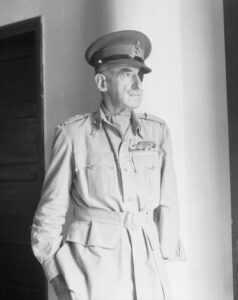 he sustained 11 grievous injuries, and simply could not be killed in war.
he sustained 11 grievous injuries, and simply could not be killed in war.
En route home via French Indochina, Carton de Wiart stopped in Rangoon as a guest of the army commander. Coming down the stairs, he slipped on coconut matting, fell down, broke several vertebrae, and knocked himself unconscious. He was admitted to Rangoon Hospital where he was treated and recovered. His wife died in 1949. Then, in 1951, at the age of 71, he married Ruth Myrtle Muriel Joan McKechnie, a divorcee known as Joan Sutherland, 23 years his junior (born in late 1903, she died January 13, 2006, at the age of 102.) They settled at Aghinagh House, Killinardrish, County Cork, Ireland. Carton de Wiart died at the age of 83 on June 5, 1963. He left no papers. He and his wife Joan are buried in Caum Churchyard just off the main Macroom road. The grave site is just outside the actual graveyard wall on the grounds of his own home.
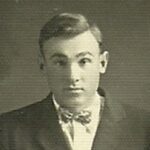
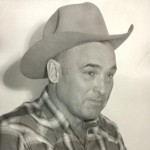 When my husband, Bob’s grandfather, Andy Schulenberg was a boy of 14 years, he was involved in a hunting accident, in which his leg was injured. Things were different in those days, and medicine just wasn’t as advanced as it is now. Not that medicine was antiquated in 1920, but much has been learned about how to save limbs since those days. Grandpa’s leg did not fare well, and after fighting infections, most likely gangrene, and losing the battle, it became apparent that if they were to save his life, they would have to sacrifice the leg.
When my husband, Bob’s grandfather, Andy Schulenberg was a boy of 14 years, he was involved in a hunting accident, in which his leg was injured. Things were different in those days, and medicine just wasn’t as advanced as it is now. Not that medicine was antiquated in 1920, but much has been learned about how to save limbs since those days. Grandpa’s leg did not fare well, and after fighting infections, most likely gangrene, and losing the battle, it became apparent that if they were to save his life, they would have to sacrifice the leg.
Following the accident and with the amputation, Grandpa send 14 months in the hospital. Now that’s a long time for anyone, but for a 14-year-old boy, that must have felt like an eternity. He missed a year of school, as well as all the fun things kids that age were doing. He also missed helping his parents with various chores, something which might not seem to be a negative thing, but when boredom sets in, a person would far rather work on the farm than lay in a bed. While inventors had dabbled 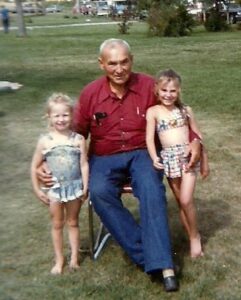
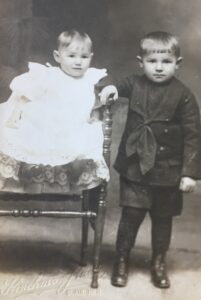 with the invention of the television, it was by no means perfected, and so he basically had the visitors who came in and books for entertainment. Not much fun really, especially since a lot of boys aren’t terribly interested in reading. Thankfully for Grandpa, his family tried to rally around him, and he received a number of postcard letters during that time. I would imagine he lived for the mail delivery, hoping he got a letter, after which he devoured the words on the page, even if the writer didn’t always pick their words very carefully. It was his connection to the outside world.
with the invention of the television, it was by no means perfected, and so he basically had the visitors who came in and books for entertainment. Not much fun really, especially since a lot of boys aren’t terribly interested in reading. Thankfully for Grandpa, his family tried to rally around him, and he received a number of postcard letters during that time. I would imagine he lived for the mail delivery, hoping he got a letter, after which he devoured the words on the page, even if the writer didn’t always pick their words very carefully. It was his connection to the outside world.
Grandpa was fitted with a wooden peg leg, but it would still be a long road learning to walk with it. I never knew exactly how high the leg went, but I believe it was probably mid-thigh. It was during this time that Grandpa would show his true fortitude He could have laid in that bed, giving up and letting other people take care of him, but he didn’t do that. He got up and worked hard to recover his mobility. Sure, he knew that things would never be the same, but he had things he wanted to do, and he was determined not to let this take him out of commission.
He went on to become the Sheriff of Rosebud County. One might think that he would never want anything to do with guns again, but while he didn’t really see the need for them much as sheriff, he was still well able to use 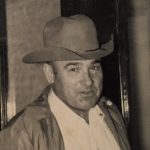
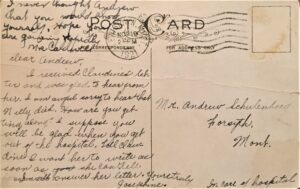 them. He was sheriff between 1955 and 1972, and during that time, he was well known as “the sheriff without a gun.” It’s hard to imagine a sheriff who has a reputation big enough to be able to work without a gun, including making arrests, but that was what he did. I don’t know if guns bothered him or not, but if so, he was quite successful at hiding it. Today is the 116th anniversary of Grandpa’s birth. Happy birthday in Heaven, Grandpa Schulenberg!! We love and miss you very much.
them. He was sheriff between 1955 and 1972, and during that time, he was well known as “the sheriff without a gun.” It’s hard to imagine a sheriff who has a reputation big enough to be able to work without a gun, including making arrests, but that was what he did. I don’t know if guns bothered him or not, but if so, he was quite successful at hiding it. Today is the 116th anniversary of Grandpa’s birth. Happy birthday in Heaven, Grandpa Schulenberg!! We love and miss you very much.
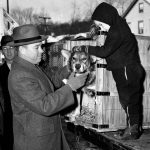
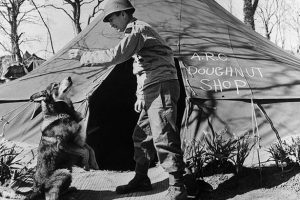 As most of us know, dogs have been used in many kinds of work from K-9 units to military units to guide dogs, to cadaver dogs, and many more. During World War II, one such dog named Chips, who was a Shepherd-Collie-Husky mix, served for 3.5 years of the war. When the US entered World War II, the military actually asked Americans to “donate” their dogs to serve on patrols and guard duty. That seems so strange to me. How could the dog know what was going on? How could it not get depressed or aggressive, thinking its owner was dead or had abandoned it? It’s one thing to send a soldier into a war situation, they have either been legally drafted or they freely joined up, but a dog…or any animal for that matter, couldn’t possibly understand why, after having a family of their own, they were suddenly in a foreign country, without their owner, their own bed, or their home.
As most of us know, dogs have been used in many kinds of work from K-9 units to military units to guide dogs, to cadaver dogs, and many more. During World War II, one such dog named Chips, who was a Shepherd-Collie-Husky mix, served for 3.5 years of the war. When the US entered World War II, the military actually asked Americans to “donate” their dogs to serve on patrols and guard duty. That seems so strange to me. How could the dog know what was going on? How could it not get depressed or aggressive, thinking its owner was dead or had abandoned it? It’s one thing to send a soldier into a war situation, they have either been legally drafted or they freely joined up, but a dog…or any animal for that matter, couldn’t possibly understand why, after having a family of their own, they were suddenly in a foreign country, without their owner, their own bed, or their home.
Nevertheless, when their country asked, over 11,000 Americans volunteered their pets, including Chips’s owner, John Wren of Pleasantville, New York. Chips the first “volunteer” dog in the United States, took part in the invasion of Sicily, just a year into his deployment. When an Italian machine gunner pinned down Chips and his squad, he broke away from his leash and charged into the enemy position. A single shot rang out. Then, the Italian gunner emerged with Chips at his throat, followed by three more soldiers. They all quickly surrendered. Chips received a wound on his scalp and burns on his mouth and left eye. That didn’t stop this hero dog, who kept fighting and helped capture 10 more soldiers that day.
After the war, per their request, it was time for Chips to be returned to his family. Plans would have to be put in place for that to happen. So, in the fall of 1945 he was taken back to Front Royal where he was retrained so that he could go back to his family. A dog who had been in combat couldn’t just go back to his family as if nothing had happened. Finally in December of 1945, he traveled home to Pleasantville, riding in the baggage car of a train. He didn’t go alone. He was accompanied by six reporters and photographers who wanted to 
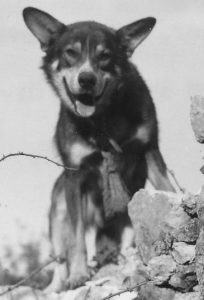 cover the story. They were met by Mr and Mrs Wren and their son, Johnny, who was only a baby when Chips left. The girls raced home after school to see their dog. It was a sweet homecoming. Chips lived for just four months before his kidneys failed. I guess war had taken its toll.
cover the story. They were met by Mr and Mrs Wren and their son, Johnny, who was only a baby when Chips left. The girls raced home after school to see their dog. It was a sweet homecoming. Chips lived for just four months before his kidneys failed. I guess war had taken its toll.
Chips’s story made him an international sensation. He received a Silver Star for his heroics. Unfortunately, some people thought that a dog shouldn’t be awarded the same medal as a human, so it was revoked. Then, in 2018, he was awarded the PDSA Dickin Award, the highest honor for wartime bravery for an animal. A well-deserved honor. While his award was amazing, I think that the family should have also received an award, as should all of the other families who donated their dogs for the war effort. It was a very selfless act.

